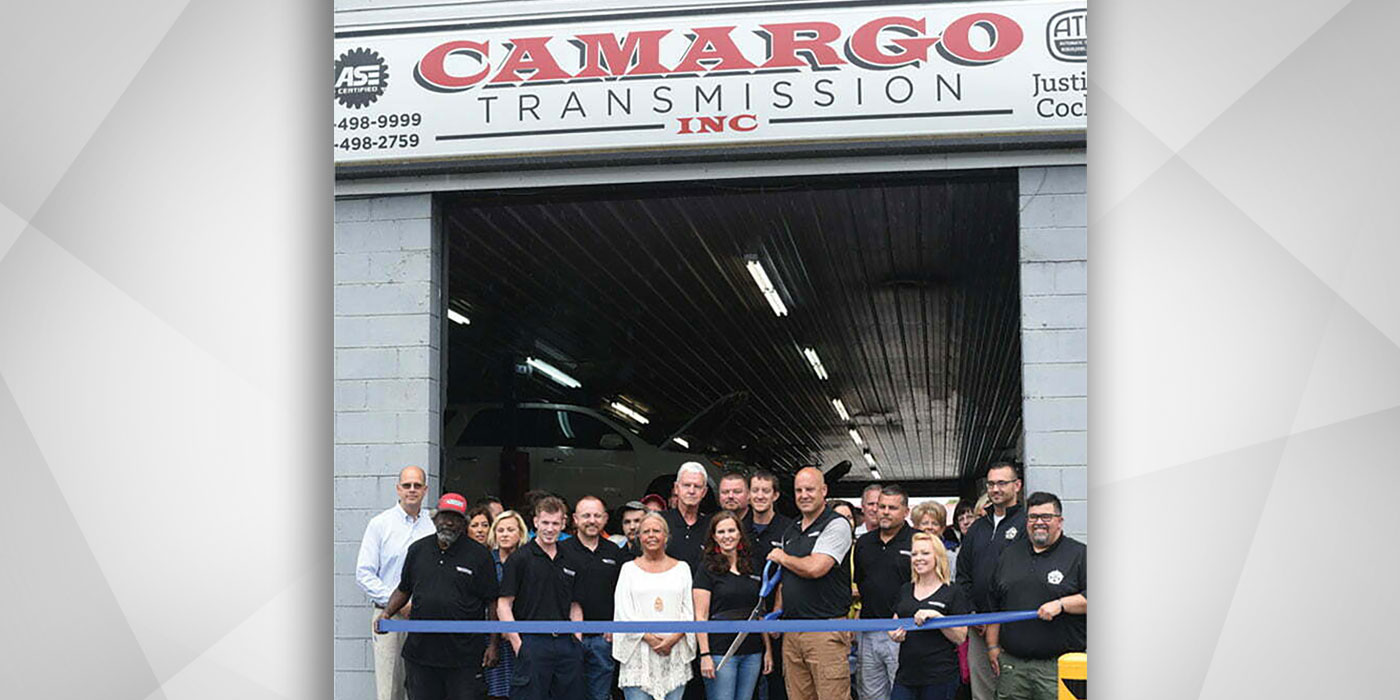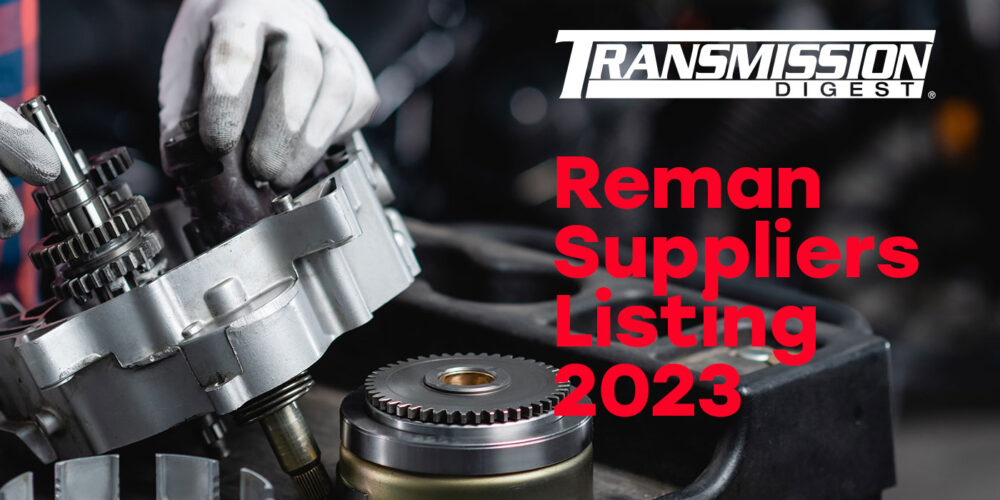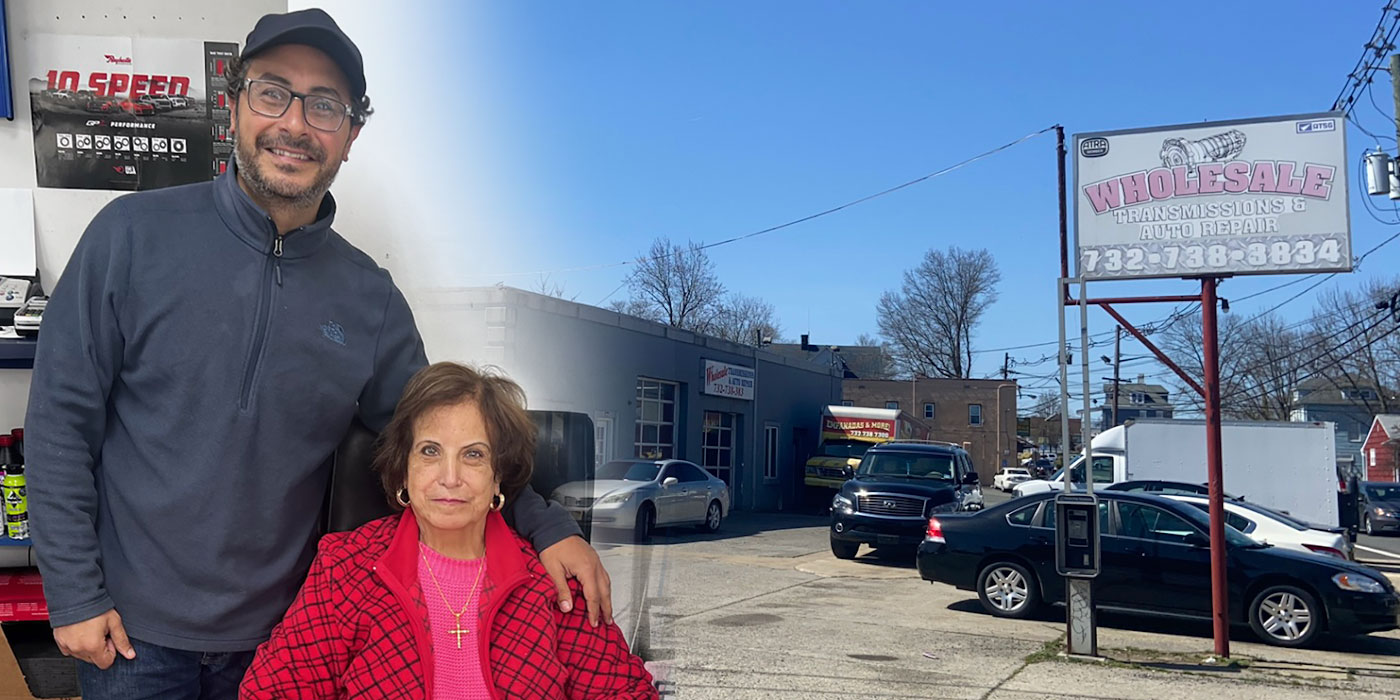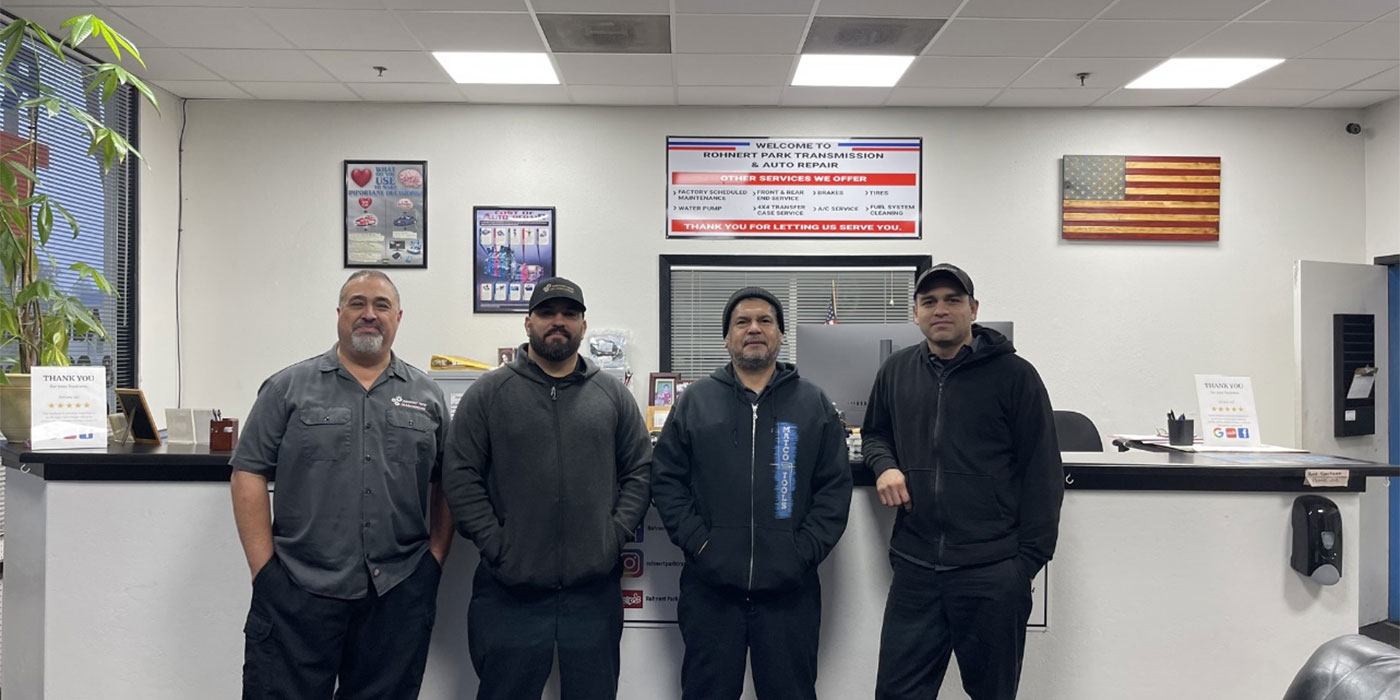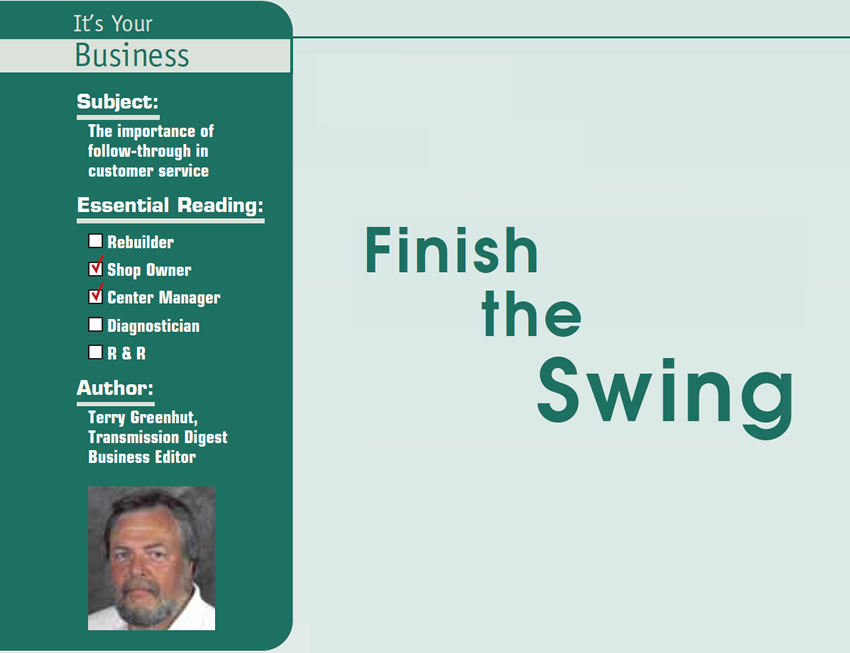
It’s Your Business
- Subject: The importance of follow-through in customer service
- Essential Reading: Shop Owner, Center Manager
- Author: Terry Greenhut, Transmission Digest, Business Editor
Pardon me for all the golf analogies I use. It’s just that to me the game of golf is an awful lot like the games of business and life. It has so many of the same elements.
There are the good shots and the bad, many times caused by the good and bad decisions we make just before or as we are hitting them. There is the attitude we bring to the course on any given day, same as the attitude we bring to work or to our personal relationships. There are the distractions that can keep us from playing or working well if we let them.
There is the way we approach the game and our businesses. Do we play to win or just to play? There is the luck of a ball bouncing the right way or the unlucky occurrence of it bouncing wrong. Then there is the recovery shot when it doesn’t bounce right. Can we save our par; can we save the day in our business?
There is the honesty or the lack thereof. Do we play the ball where it lies (as the rules state) or do we move it from behind the tree to get a better shot? Are we honest with ourselves, our customers and our employees?
Do we know our strengths and weaknesses so we can capitalize on the former and work on the latter?
The reference to finishing the swing has to do with the completeness of our actions. In golf, if you stop the swing just as the club makes contact, the ball isn’t likely to go very far or straight or up in the air for that matter. Any pro will tell you that you have to finish the swing, meaning to follow through, if you want good, consistent results.
Many of us don’t finish the swing in our relationships with customers. Some of us have mastered the art of taking them through the sales process and making certain that their vehicles are properly repaired, but we aren’t great at working the relationship that should follow such a successful beginning. Sometimes it’s because we don’t know what to do next or how to do it. More often it’s because we don’t see the importance of following through because that doesn’t get us the instant gratification that we desire and are used to. We’re into sell it, fix it and collect the money for it, then move on to the next job. The so-called after-sale has little importance because it doesn’t generate instant revenue. It’s future money, and you can’t count or spend future money. You also can’t touch it, smell it or taste it; therefore, it doesn’t carry much if any importance. What’s important is now, today, this week.
The problem is that if you don’t start to follow through you might not have much of a future in this business. Relationships are everything today. You can’t rely on advertising to build a business the way you used to, because everybody is advertising the same services. The unique skills we possess as transmission experts are being assimilated into the mainstream of auto repair and services. So if our advertising to get new customers doesn’t give us an edge over our competitors, we need something that will.
We have it, but many of us don’t realize it. It’s a base of customers we’ve already satisfied. Yes, we might have worked on only one part of their cars, but it is one of the most-expensive and complex parts they are likely to ever have fixed. So there is a good chance that after we’ve fixed it to their satisfaction they may just want us to do other repairs and services. In fact, we all know that many of them have asked over the years, “Do you do any other kind of repairs here?” They were trying to tell us how much they trust us by asking that question.
Being a transmission guy has always been the coolest thing to be in the automotive trades, because mechanics who don’t work on transmissions are always a little bit in awe of those who understand how they work and are able to fix them. It’s really great if you own or are employed by a shop that does enough transmission work that it doesn’t need to perform other functions.
The reality is that most of us don’t have the luxury of specializing in only one area anymore. We have to add more specialties or just take the plunge and begin to service the entire vehicle.
The major difference between the transmission specialty and providing nearly all the necessary auto repairs and services doesn’t lie in the difficulty of the work. The work is the work. Most jobs on a car are far easier to do than transmission work, and most mechanics who do transmission work can fix almost anything on a car with little or no additional tools or training. The difference lies in the volume of vehicles and the number of customers that must be handled.
A transmission shop that writes five to 10 repair orders a week can gross $10,000-$25,000 in that period, but a general-repair business would need to write three to four times that amount and deal with that many more customers to gross similar numbers. The “transmission-only” shop might not care all that much about following up with additional maintenance and services other than those that could adversely affect their transmission repair, so no great amount of after-sale contact would need to be done other than to check and make sure the job went well and the customer was happy.
In general repair, continual contact is necessary. Unlike transmission work that’s completed when the transmission is returned to full functionality, the rest of the vehicle is never finished being repaired and serviced. There is always more to do.
The follow-through is the act of finding and recommending additional repairs and services, then following up to make sure customers have them done – and if they don’t, trying again and again to sell them. It’s also about getting customers’ vehicles on a regular maintenance schedule so you have a valid reason to contact them when their services are due.
More than any other action you can perform, the future success of your business relies on how well you can stay on top of your customers’ ongoing maintenance requirements. Mailing out or e-mailing service reminders and following up with phone calls is the only way to get it done. It’s a constant. It can’t be done for just one or two months when business gets slow or when you feel guilty about having let it slide. Follow-up needs to be done relentlessly. Mail should be going out every week and phone calls made every day. It should become part of the routine of the shop, with somebody in charge of making sure it gets done.
Transmission people as a rule never scheduled much of anything in the way of appointments. They were famous for being the “first-come, first-served” segment of the auto-repair industry. That’s why most of their sales graphs resembled the roller-coaster ride at the local amusement park. They would go from really busy to really slow and back to really busy in a matter of days.
Today’s success lies in smoothing out that bumpy road, getting rid of those hills and valleys by filling up the shop’s schedule at least a week in advance. Don’t worry about leaving time slots open for checking vehicles or for emergency repairs. Squeeze them in as add-ons to the schedule. You need to sell every hour of available shop time every week. You don’t have the luxury of selling only 100 hours of billable time when you have 200 available. Every hour goes toward paying a bill or making some profit. They must all be sold.
Once more, follow-through comes into play. So you’ve made all these bookings. Will they all show up? They will if you call them in advance to remind them. If any of them can’t make it for any reason it at least will give you a chance to sell that open time. Just like at the golf course, we are successful only if we sell all those open times. Time is fleeting. Once it’s gone there’s no getting it back. We have it, then we don’t.
When you figure out that your entire universe of time is the calculation of the number of technicians you have times the number of hours they are available to work, you will know, for example, that four technicians each available to book 40 hours a week gives you a universe of 160 hours to sell. You need to sell as close to all of it as you can. If you lose any of it you can’t get it back! Another consideration is that every hour of time that isn’t sold has a corresponding parts profit that isn’t realized. No labor sale = no parts sale.
If there is an advantage that transmission people have, it’s in customer service. If we know anything at all it’s how to take care of customers with major issues. We have been known to bite the bullet many times for thousands of dollars in our effort to keep customers happy. Most of the other automotive trades have never had to give back that much and would be shocked by the thought of it. We do it in the regular course of doing business. In other words, we know how to smile when it hurts, an art that many others have not mastered.
This is where we need to “finish the swing,” where we have to have the follow-through. We need to be on top of every job and every customer situation. We can’t take anything for granted. “Good enough” is no longer a phrase to be in our vocabulary. Nothing is good enough. It’s either 100% right or it isn’t, and if it isn’t it has to be fixed. You can’t let out a car that isn’t 100%. You can’t let customers talk you into compromising your principles to take on low-priced jobs you know you shouldn’t do. You can’t let employees who have no financial interest in your company dictate customer policy. They should be welcome to make suggestions, but the ultimate decisions must lie with the owners.
Here’s a situation from another business that indicates why we have to either be perfect or have a means to rectify a problem quickly and with perfection. The pharmacy from which I get my prescriptions is usually pretty good about getting things right, but not always. The problem is that when they don’t get something right, fixing it becomes a major problem because they apparently do not have a system for handling such situations.
Case in point: Last week I called in to have some prescriptions refilled. Each prescription has a unique number, so it’s pretty hard to screw up; you would really have to try. They punch the number into their computer and it tells them the name and address of the patient and the doctor, the medicine, the dosage, any interactions there might be with other drugs the patient takes and how many refills are left before they have to call the doctor to see whether it can be extended – not rocket science.
One of the prescriptions called for 60 pills in a 30-day supply, because I take one in the morning and another at night. The vial showed up with only 30 pills in it. When I called I was immediately told that the doctor lowered the dosage to one pill a day. That was a lie. My doctor would never change one of my meds without first consulting me. So, strike one.
After a minute of muffled gibberish, while he was talking with someone else with his hand over the mouthpiece, he said they had made a mistake and would send the other 30 pills over to my house. They never got there. Strike two.
I called yesterday to see what happened. “Oh, we’re so sorry. We’ll send them right over.” They didn’t. Strike three. They never finished that swing, losing my trust – possibly forever.
Following through or not with perfect performance, appointment scheduling and customer service will make the difference between the shops that will prosper and those that will barely squeak by or fall by the wayside. The winners will be the shops that make a good profit by building and maintaining the largest base of happy customers.

Visit www.TerryGreenhut.com.




